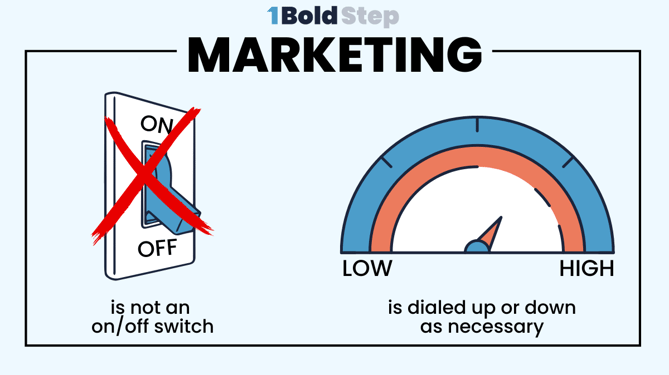Unless you are an economist, you might find the latest economic outlook a bit confusing. Judging from all the conflicting opinions, even the economists are confused. What we do know is that the economy is always changing, and usually trending in one direction or another. As business owners, we try to anticipate those trends, or at least respond quickly to them. Part of that response is adjusting how we are doing our marketing to fit the economic environment.
The Current Economic Outlook
The COVID-19 pandemic was a unique situation for all of us. The last society-changing pandemic was in 1918. Anyone in business from that time has passed on, so there are no mentors to consult. Technology has also rapidly progressed, so the ground rules, whatever they were, must have changed too.
What we do know is that COVID-19 created a worldwide recession which is mirrored in the United States. Or is it? Supply chain problems and restrictions on travel resulted in a huge increase in inflation and Gross Domestic Product in the U.S. declined for two quarters in a row. These are classic indicators of economic recession.
At the same time, we are seeing incredibly low unemployment rates, a lot of hiring, rising wages, and a very tight labor market. Which, really, are not indicators of a recession. All we can say is that we may be in a recession, coming out of a recession, not in a recession, or about to get into a recession. You get my point. It all begs the question: what is a savvy business owner to do with their marketing?
Agility is the Key
One answer is to treat your marketing like it has an on-and-off switch. In the good times, you spend, spend, spend. While in uncertain times, you cut the budget. This saves you money and resources that can be used to wait out the bad times. It's also a great way to lose market share and position yourself far behind your competition. Turning your marketing on and off is not a good strategy.
As a better alternative, think of your marketing as a dial. You can dial up or down as needed. By developing a marketing strategy with a number of different facets, all of which show a measurable ROI, you can ramp them up or down based on market conditions.
Marketing works at the intersection of scarce resources and human wants and needs. Your customers aren’t going to suddenly stop having the challenges that your products solve. They may not be able to pull the trigger on a purchase, but as their issues mount, they certainly will be doing the research to find the best solution. Once their finances change, they will make that purchase as soon as they can.

Tactics You Can Use
As the economy changes you will want to dial your marketing up or dial down in response. It may seem counterintuitive, but in a recession, you'll want to dial your marketing UP to stimulate demand. In a bull market, you may want to dial your marketing DOWN so demand doesn't outpace supply, or to reallocate those dollars towards growth initiatives.
Here’s a list of techniques you can use whether you are dialing up or dialing down.
Dialing the Marketing UP:
- Widen the net. Look to industries that are adjacent to or similar to your current target market and create a full, new, go-to-market plan to build additional demand.
- Invest in buyer intent/targeted contact data. Look to companies like ZoomInfo, Uplead, Seamless.ai, Linkedin and others. Invest in lists of contacts that fit your ideal customer profile and have shown some inclination towards your products and their online behavior. Get creative with marketing automation to reach out, educate, and stimulate demand (do not sell!) about the problems you solve. Show them your expertise.
- Invest in paid, digital advertising that is targeted to your ideal audience (but maybe just a bit broader than usual) and consider lead magnets like eBooks, checklists, and other useful offerings that do not sell to, but rather, educate your potential customers.
- Consider adding an inside sales team or contracting a service that does nothing but find, nurture, and tee up meetings for your seasoned sales veterans (who don’t have time to prospect).
- Create a strong purchase offer ($ valued) as a way of closing deals that have been stuck in the pipeline. Consider what it might take to get those deals moving again.
- Launch a “we miss you” campaign with a strong offer. When is the last time you talk to attrited/lost customers? Doing this is a great (and inexpensive) way to generate new revenue.
- Launch a cross-sell campaign. Do you have customers that only buy a small portion of your product/service offering? Cross-sell campaigns are another easy way to increase revenue from your existing customer base.
Dialing the Marketing DOWN:
- Reduce your marketing spend. Turn off or shrink expensive campaigns, trade show tours, or other expenditures not directly tied to generating sales.
- Put a freeze on hiring. Instead, contract fractional marketing team players. Use just as much marketing help as you need.
- Expand your product offering. When was the last time you ran a focus group, surveyed, or interviewed your ideal clients to learn more about their daily challenges? In good economic times, you should use your momentum to innovate and improve your current products and services.
- Review and refresh your inbound content strategy. Set up an editorial calendar based on the questions people are asking your sales team (and Google) and start blogging the answers to their questions. Use this marketing downtime to create a library of content that continues to establish you as the expert in your industry.
- If you’re writing really good content that solves problems in the industry, consider pitching your stories to industry associations. Their members are likely your target audience and they will often welcome new content (as long as it isn’t salesy).
- Clean up your database. Run records through Neverbounce, deduplicate, and add data points that will allow for better segmentation. Get your house in order!
- Upgrade or tune up your marketing technology stack. Is your marketing automation optimized? This is a good time to focus on your systems and make sure they are working at their best.
Have an Agile, Strategic Marketing Plan in Good Times or Bad
At some point, the economic conditions will change... for better or for worse. You need to be able to move with the times. Being agile doesn't mean that you never make a plan. It means that you examine your plan on a regular basis, keep what makes sense, and change what needs changing.
Here at 1 Bold Step, we start most new engagements with a Strategic Marketing Plan Workshop. This is a one-day workshop (fee: $7,500) where we guide your marketing and leadership team in creating a marketing plan that specifically helps achieve the company's stated goals. The result is twofold:
- A one-page marketing plan that can easily be communicated to key constituents in your organization.
- A detailed marketing plan that includes everything from high-level focus areas, KPIs, a budget, and tactical, prioritized, action items.
As we roll into 2023, make sure you get off on the right foot by creating a strategic marketing plan that will guide you through the year. You don't need to be married to it. As the economic environment changes, you can adjust your plan accordingly. At 1 Bold Step, we call this "dynamic steering." It's just like riding a bike. You point the bike in the right direction, make a plan where to go, and start peddling — but to keep your balance and avoid obstacles, you move the handlebars as and when needed.
If you’d like help creating your strategic marketing plan, please reach out. We'd love to help you. You can email us at info@1boldstep.com or call us at  .
.





